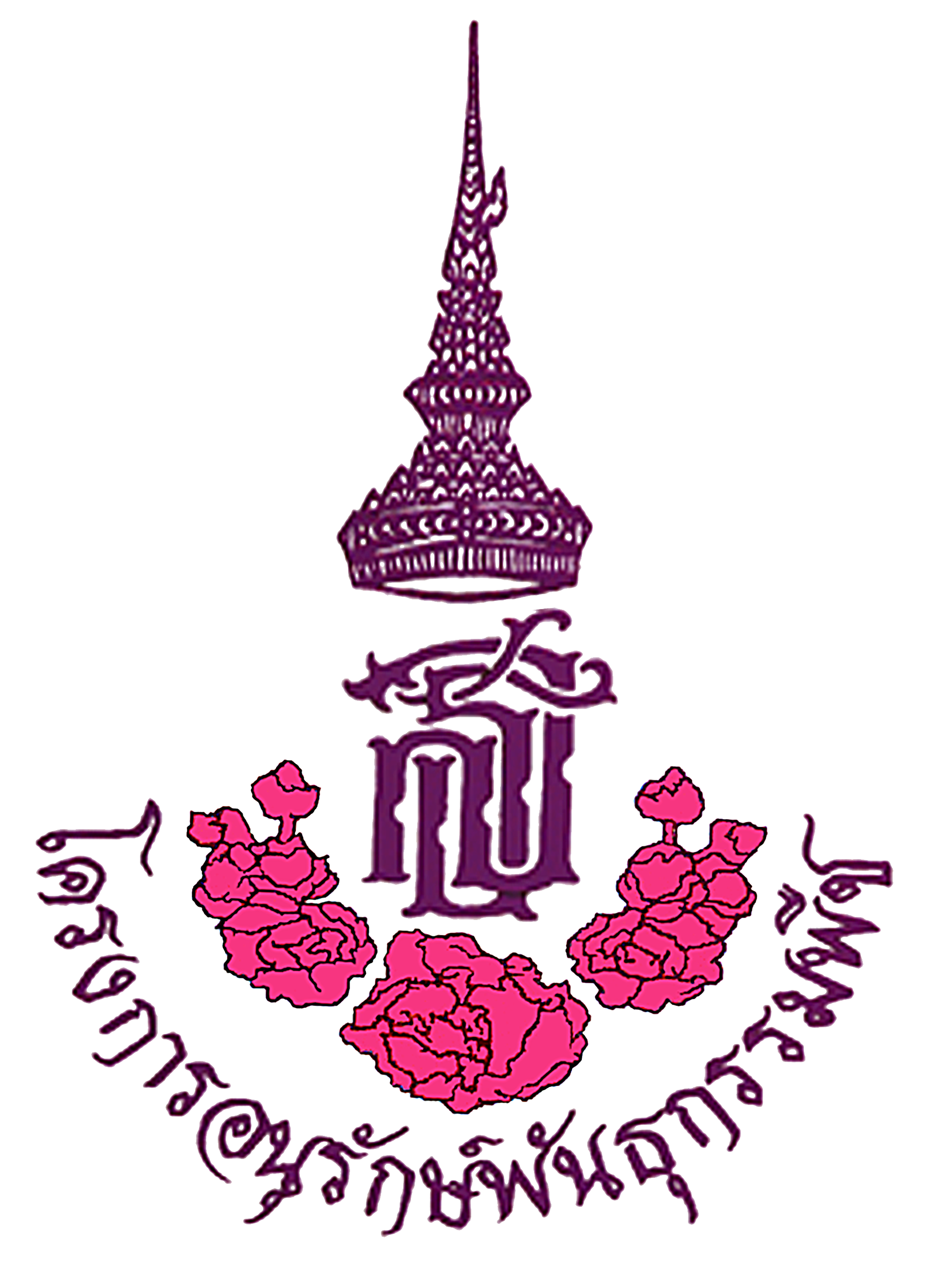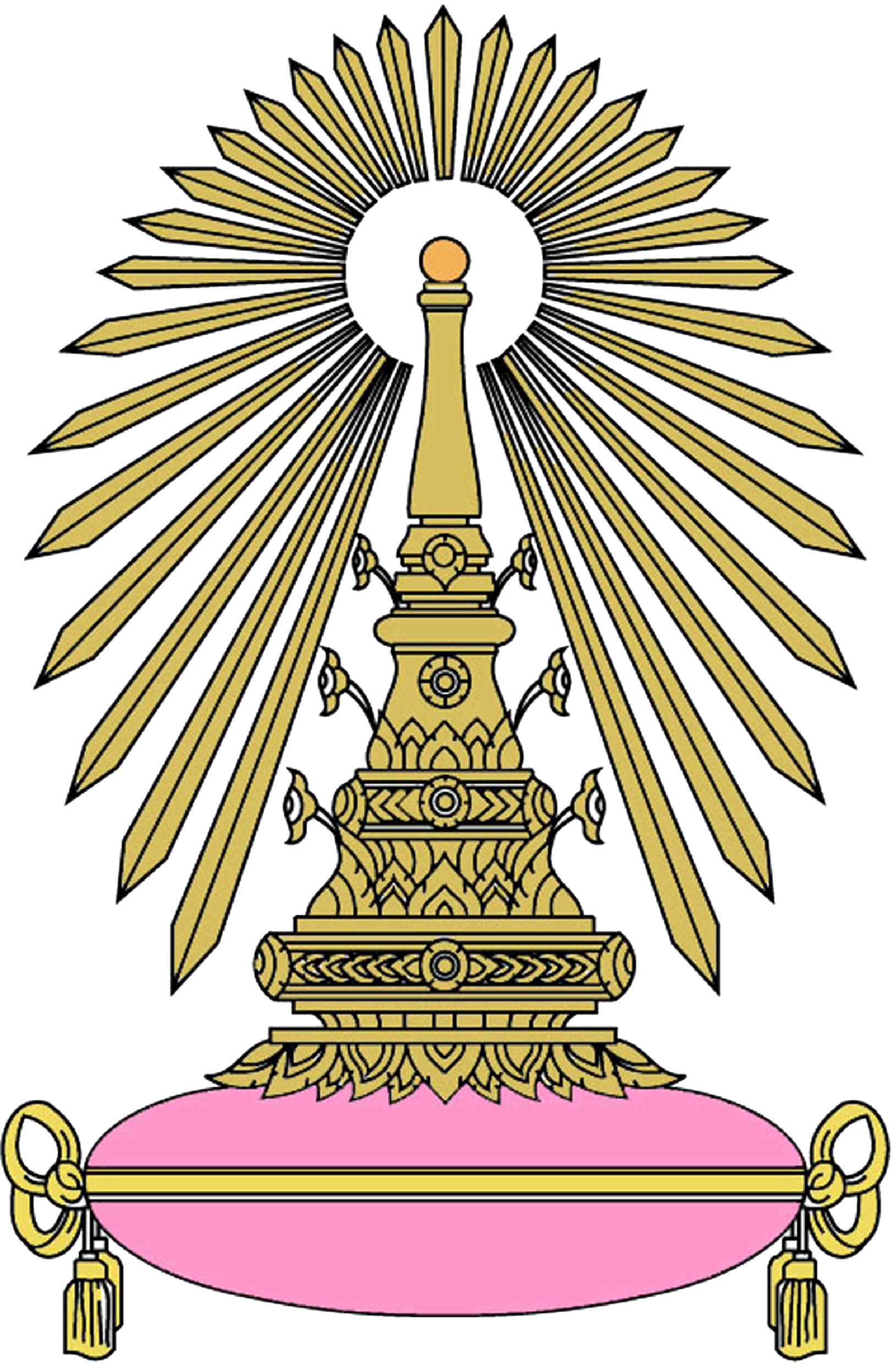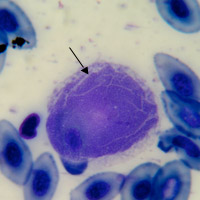 |
 |
 |
 |
 |
สัณฐานวิทยาและพยาธิสภาพของปรสิตบางชนิด ในพื้นที่ อพ.สธ. (Morphology and histopathology of some parasites in the RSPG area) รศ. ดร. มาลินี ฉัตรมงคลกุล |
บทคัดย่อ
การศึกษาครั้งนี้แบ่งออกเป็น 2 ตอน ตอนที่ 1 ศึกษาความชุกของการติดปรสิต สัญฐานวิทยา และพยาธิสภาพที่เกิดจากปรสิตในเลือดของสัตว์สะเทินน้ำสะเทินบกและสัตว์เลื้อยคลานในพื้นที่ อพ.สธ. ได้แก่ หมู่เกาะสุรินทร์ จ. พังงา และ หมู่เกาะลันตา จ. กระบี่ ระหว่างปี พ.ศ. 2555 ถึง 2556 จำนวนสัตว์ที่ศึกษารวม 161 ตัว ตรวจปรสิตในเลือดโดยทำแผ่นฟิล์มเลือดบนกระจกสไลด์ ย้อมด้วยสียิมซ่า การศึกษาปรสิตในเลือด ในพื้นที่หมู่เกาะสุรินทร์ จังหวัดพังงา พบว่า จากสัตว์สะเทินน้ำสะเทินบก 4 ชนิด จำนวน 60 ตัว มีเพียง กบบัว (Rana erythraea) จำนวน 5 ตัว ที่มีการติดปรสิตในเลือด (ความชุกการติดปรสิตรวม 8.33%) ปรสิตที่พบได้แก่ Trypanosoma chatonii และ Aegyptianella sp. และ จากสัตว์เลื้อยคลาน 8 ชนิด จำนวน 13 ตัว มีเพียงตุ๊กแกป่าสุรินทร์ Cyrtodactylus surin จำนวน 1 ตัว ที่มีการติดปรสิต Hepatozoon sp. (ความชุกการติดปรสิต 7.69%) สำหรับการศึกษาปรสิตในเลือดในพื้นที่หมู่เกาะลันตา จ. กระบี่ พบว่า จากสัตว์สะเทินน้ำสะเทินบก 7 ชนิด จำนวน 84 ตัว มีการติดปรสิตในเลือด 14 ตัว (ความชุกของการติดปรสิต = 16.67%) สัตว์สะเทินน้ำสะเทินบกที่ติดปรสิตมี 4 ชนิด ได้แก่ กบทูด (Limnonectes blythii), กบหนอง (Fejervarya limnocharis), คางคกหัวจีบ (Bufo parvus) และ กบห้วยขาปุ่มจารุจินต์ (Limnonectes jarujini) ปรสิตที่พบจำแนกเป็น 7 ชนิด ได้แก่ Aegyptianella sp., Hepatozoon sp., Lankesterella sp., Trypanosoma chattoni, Trypanosoma sp., microfilaria และ ที่ไม่สามารถจำแนกได้ 1ชนิด และพบว่า จากสัตว์เลื้อยคลาน 2 ชนิด จำนวน 4 ตัว มีการติดปรสิตในเลือด 1 ชนิดคือ หนอนพยาธิตัวกลมกลุ่ม microfilaria ในเลือดของ จิ้งเหลนบ้าน (Mabuya multifasciata) 2 ตัว (ความชุกของการติดปรสิต = 50%)
จากการศึกษาภายใต้กล้องจุลทรรศน์พบว่า เซลล์เม็ดเลือดแดงที่ติดปรสิต Hepatozoon sp. ระยะ แกมีโตไซท์ มีขนาดใหญ่ขึ้น นิวเคลียสถูกเบียดไปอยู่ริมเซลล์
ตอนที่ 2 ศึกษาความชุกและสัณฐานของเซอร์คาเรียที่พบในหอยน้ำจืดในพื้นที่สวนสัตว์เปิดเขาเขียว จังหวัดชลบุรี ระหว่างเดือนพฤศจิกายน พ.ศ. 2555 ถึง มกราคม พ.ศ. 2556 เก็บตัวอย่างหอยโดยใช้มือจับจากแหล่งน้ำ 6 แห่ง รวมทั้งสิ้น 1,446 ตัว จำแนกเป็น 7 ชนิด ได้แก่ หอยขม (Filopaludina martensi) จำนวน 602 ตัว หอยคันชนิดที่ 1 (Lymnaea rubiginosa) จำนวน 377 ตัว หอยคันชนิดที่ 2 (Lymnaea sp.) จำนวน 208 ตัว หอยคันชนิดที่ 3 (Indoplanorbis exustus) จำนวน 16 ตัว หอยเจดีย์ (Melanoides tuberculata และ Clea helena) จำนวน 22 ตัว และ หอยเชอรี่ (Pomacea canaliculata) จำนวน 221 ตัว ตรวจหาเซอร์คาเรียโดยวิธีทุบเปลือกหอย ศึกษาสัณฐานวิทยาของเซอร์คาเรียจากตัวอย่างสด ย้อมสี และกล้องจุลทรรศน์แบบส่องกราด ผลการศึกษาพบว่า ความชุกของการติดเซอร์คาเรียรวมเท่ากับ 1.31% (1,446/19) และสามารถจำแนกกลุ่มเซอร์คาเรียได้เป็น 4 กลุ่ม 6 แบบ ได้แก่ furcocercous cercariae (Fc.type1, Fc.type2), gymnocephalous cercaria of pleurolophocerous type (Gc.), pleurolophocercous cercariae (Pc.), และ xiphidiocercariae (Xc.type1, Xc.type2) แหล่งน้ำที่ 1, 3 และ 6 ไม่พบการติดเซอร์คาเรีย แหล่งน้ำที่ 2 มีการติดเซอร์คาเรีย Fc.type1, Fc.type2 และ Gc. ในหอยคันชนิดที่ 1 (Lymnaea rubiginosa) ความชุกเท่ากับ 3.76% แหล่งน้ำที่ 4 มีการติดเซอร์คาเรีย Xc.type1 ในหอยขม (Filopaludina martensi) ความชุกเท่ากับ 0.83% และ แหล่งน้ำที่ 5 มีการติดเซอร์คาเรีย Xc.type1 และ Xc.type2 ในหอยขม (Filopaludina martensi) ความชุกเท่ากับ 2.0% และติดเซอร์คาเรีย Pc. ในหอยเจดีย์ (Melanoides tuberculata) ความชุกเท่ากับ11.0%
คําสําคัญ: ปรสิตในเลือด สัตว์สะเทินน้ำสะเทินบก สัตว์เลื้อยคลาน เซอร์คาเรีย หอยน้ำจืด
Abstract
This study was done in two parts. The first part involved the prevalence, morphology and histopathology of blood parasites in amphibians and reptiles. Blood samples were collected from 161 animals in two locations between 2012 and 2013. Blood specimens were examined using thin-filmed blood smear preparations with Giemsa staining. In location 1, mo ko Surin National Park, Pang Nga province, a total of 60 amphibians (4 species) 5 were positive for blood parasites (prevalence = 8.33%) infecting only Rana erythraea. The observed parasites included Trypanosoma chatonii and Aegyptianella sp.. Of 13 reptiles (8 species) only 1 Cyrtodactylus surin was positive with the presence of Hepatozoon sp. (prevalence = 7.69%). In location 2, mo ko Lanta National Park, Krabi province, of 84 amphibians (7 species) 14 were positive for blood parasites (prevalence = 16.67%) infecting 4 host species, Limnonectes blythii, Fejervarya limnocharis, Bufo parvus and Limnonectes jarujini. The observed parasites included Aegyptianella sp., Hepatozoon sp., lankesterella sp., Trypanosoma chattonii, Trypanosoma sp., microfilaria and unknown. Of 4 reptiles (2 species) only 2 Mabuya mulitfasciata was positive for microfilaria (prevalence = 50%). Microscopic observation revealed that red blood cells infecting with Hepatozoon gametocytes were hypertrophied and the nucleus of the host cell was displaced laterally.
The second part, the prevalence and morphology of cercariae found in freshwater snails from Khao Kheow Open Zoo, Chonburi province were investigated during November 2012 to January 2013. The snails were collected by handpicking from six sites. The total number of 1,446 snails representing 7 species was collected. They were 602 Filopaludina martensi, 377 Lymnaea rubiginosa, 208 Lymnaea sp., 16 Indoplanorbis exustus, 22 Melanoides tuberculata and Clea Helena and 221 Pomacea canaliculata. The snails were examined for cercariae using crushing methods. The morphology of cercariae was studied as alive, stained and scanning electron microscopy. The results showed that the overall cercariae infection rate was 1.31% (1,446/19). The cercariae were identified into 4 groups 6 types, furcocercous cercariae (Fc.type1, Fc.type2), gymnocephalous cercaria of pleurolophocerous type (Gc.), pleurolophocercous cercariae (Pc.), and xiphidiocercariae (Xc.type1, Xc.type2). At the site 1, 3 and 6 the snails were not infected. At the site 2, 3.76% Lymnaea rubiginosa were infected with Fc.type1, Fc.type2 and Gc. At the site 4, 0.83% of Filopaludina martensi were infected with Xc.type1. At the site 5, 2.0% of Filopaludina martensi were infected with Xc.type1 and Xc.type2 and 11.0% of Melanoides tuberculata were infected with Pc..
Key words: blood parasite, amphibian, reptile, cercaria, freshwater snail
งานวิจัยทั้งหมดมีลิขสิทธิ์
ผู้ละเมิดจะได้รับโทษสูงสุดตามที่กฎหมายกำหนด
สนใจข้อมูลเพิ่มเติม หรือมีข้อสงสัย
โปรดติดต่อโครงการฯ เพื่อการอ้างอิงหรือเผยแพร่ก่อนทุกครั้ง